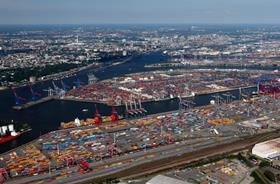
Seaborne cargo remained relatively steady through the first half of the year at the port of Hamburg, falling just 0.2 per cent to 70m tonnes.
Containerised cargo stood fast at 4.45m TEUs, while bulk cargo grew 1 per cent to 23.5m tonnes.
‘In the first half of 2017 the port of Hamburg generally succeeded in asserting itself in a difficult environment, producing a stable result compared to other German ports in the North Range,’ said Axel Mattern, joint CEO of Port of Hamburg Marketing.
Mattern stressed that container volumes in Hamburg are based on a very differing throughput trend for Hamburg’s two major container terminal operators in the first half.
'Here one company was able to profit considerably better than the other from the very extensive changes so far implemented on container liner services,' he explained. 'These caused shifts in market shares in Hamburg. Alterations in shipping company alliances and schedules often make an impact on throughput volumes and container terminal utilisation in the ports.
'In addition, fresh container handling capacities in the Western ports being put on the market for the first time cause volume increases as they come on stream, and then at the expense of other ports make a one-time impact reflected in their first-half results,' added Mattern.